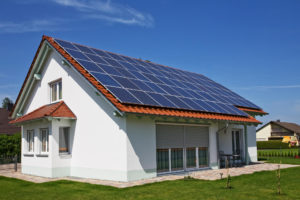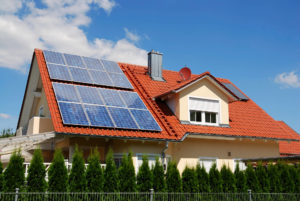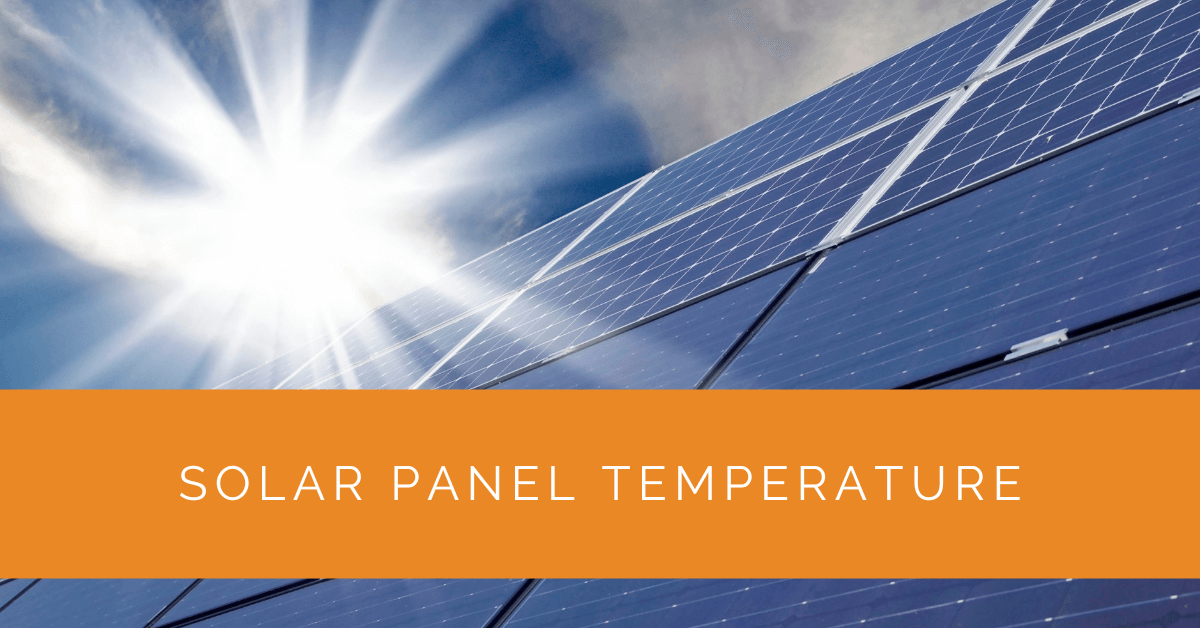Solar panels are an integral part of any solar energy system, but did you know that temperature plays a crucial role in their efficiency? This article will delve into the fascinating world of solar panel temperature and explore how it affects their performance. From the temperature coefficient to managing panel heat in hot climates, we will uncover the factors influencing solar panel efficiency and provide insights into optimizing their energy production.
Contents
- 1 Key Takeaways
- 2 Factors That Affect Solar Panel Temperature
- 3 Temperature Coefficient: Unraveling the Effect
- 4 The Impact of Temperature on Solar Panel Efficiency
- 5 Managing and Mitigating Solar Panel Temperature
- 6 Real-World Implications: How Hot Do Solar Panels Get?
- 7 Case Study: Enhancing Solar Panel Efficiency Through Temperature Management
- 8 Expert Insights From Our Solar Panel Installers About Understanding Solar Panel Temperature and Its Impact on Efficiency
- 9 Experience Solar Excellence with Us!
- 10 Conclusion
- 11 FAQ
Key Takeaways
- Solar panel temperature significantly impacts their efficiency and performance, and understanding its effect is crucial for optimizing energy production.
- The temperature coefficient quantifies how solar panel efficiency is affected by temperature changes, and selecting panels with favorable coefficients can enhance system performance.
- Proper management and mitigation strategies, such as ventilation, shade, and cooling measures, are essential for managing solar panel temperatures and maximizing their efficiency.
Factors That Affect Solar Panel Temperature
Various factors influence solar panel temperature; understanding them is vital for optimizing their performance. Here are some key factors that can affect the temperature of solar panels:
- External Environmental Factors: Ambient temperature, sunlight intensity, and air quality are external factors that impact how hot solar panels get. Higher ambient temperatures and intense sunlight can lead to increased panel temperatures. Poor air quality, such as dust or pollution, can also affect panel temperature by reducing sunlight absorption and causing heat buildup.
- Panel Placement and Orientation: The placement and orientation of solar panels can significantly impact their temperature. Panels directly exposed to the sun for extended periods, especially in hot climates, tend to absorb more heat. The angle at which the panels are mounted and their tilt towards the sun can also influence temperature variations.
- Roof Material and Color: The material and color of the roof beneath the solar panels can affect their temperature. Dark-colored roofs absorb more heat, which can increase the panels’ temperature. In contrast, lighter-colored or reflective roofs reflect more sunlight and help keep the panels cooler.
Understanding these factors helps solar system designers and installers make informed decisions regarding panel placement, mounting, and cooling strategies to optimize panel temperature and efficiency.
Temperature Coefficient: Unraveling the Effect
The temperature coefficient is a crucial parameter that quantifies how solar panel efficiency is affected by temperature changes. It provides valuable insights into how panel performance varies with temperature. Here’s a closer look at the temperature coefficient and its effect on solar panel efficiency:
- Definition of Temperature Coefficient: The temperature coefficient represents the percentage change in the power output of a solar panel for every degree Celsius of temperature increase. It is expressed as a percentage per degree Celsius (%/°C).
- Positive and Negative Temperature Coefficients: Solar panels have either a positive or negative temperature coefficient. A positive coefficient indicates that the panel’s power output decreases as the temperature rises. Conversely, a negative coefficient suggests that the panel’s efficiency improves with temperature increases.
- Selecting Panels with Favorable Coefficients: When choosing solar panels, selecting those with lower temperature coefficients is advantageous to minimize efficiency losses caused by temperature changes. Panels with lower positive coefficients or even negative coefficients exhibit less sensitivity to temperature variations, ensuring better performance in varying climatic conditions.
Understanding the temperature coefficient allows solar system designers and installers to optimize system performance by selecting panels better suited to the environmental conditions in which they will operate.

The Impact of Temperature on Solar Panel Efficiency
Temperature plays a significant role in the efficiency of solar panels. Here’s a closer look at how temperature affects solar panel efficiency:
- Increased Resistance and Efficiency Loss: As the temperature rises, the electrical resistance of solar cells within the panels increases. This increased resistance leads to greater power losses and reduced overall panel efficiency. The temperature coefficient, as discussed earlier, defines the relationship between temperature and resistance.
- Decreased Maximum Power Output: Solar panels have a maximum power point (MPP) where they operate at their peak efficiency. Higher temperatures can shift the operating point, causing a decrease in the maximum power output. This shift can be attributed to the increased resistance and changes in the solar cell’s voltage and current characteristics.
- Optimizing Efficiency in Varying Temperatures: To maximize solar panel efficiency, it is crucial to consider temperature variations. Monitoring the temperature of the panels and adjusting system parameters, such as tilt angles and electrical configurations, can help compensate for the efficiency loss caused by increased temperature. Regular maintenance and cleaning to remove any debris or dust buildup on the panels also contribute to maintaining optimal performance.
System owners and installers can implement measures to mitigate efficiency losses and optimize energy production by understanding the impact of temperature on solar panel efficiency.
Managing and Mitigating Solar Panel Temperature
Effectively managing and mitigating solar panel temperature is essential for maintaining efficiency and prolonging the lifespan. Here are some strategies and considerations for managing panel temperature:
- Proper Ventilation and Airflow: Ensuring adequate ventilation and airflow around the solar panels helps dissipate excess heat and prevents temperature rise. This can be achieved by leaving appropriate gaps between the panels and utilizing mounting systems that facilitate airflow.
- Shade and Cooling Measures: Incorporating shade structures, such as pergolas or canopies, can help reduce the direct exposure of solar panels to intense sunlight. This helps keep the panels cooler and minimizes temperature-related efficiency losses. Additionally, cooling measures such as reflective coatings or cool roofing materials can decrease panel temperature.
- Efficient Mounting and Panel Spacing: The mounting of solar panels plays a role in their temperature management. Proper spacing between the panels and the roof surface or mounting structure allows for better air circulation, aiding heat dissipation. This prevents excessive heat buildup and helps maintain lower panel temperatures.
Implementing these strategies can help optimize the temperature conditions of solar panels, leading to improved efficiency, increased energy production, and enhanced system performance.

Real-World Implications: How Hot Do Solar Panels Get?
Solar panels can reach various temperatures in real-world scenarios depending on several factors. Here are some key considerations regarding the temperature of solar panels:
- Temperature Range: Solar panels can reach temperatures ranging from around 25°C to over 60°C (77°F to 140°F), depending on environmental conditions and panel design.
- Impact on PV Panel Output: As panel temperature increases, solar panels’ output or power production tends to decrease. The extent of the decrease depends on the panel’s temperature coefficient and the specific environmental conditions.
- Quantifying Energy Production Losses: High panel temperatures can lead to efficiency losses and reduced energy production. The magnitude of these losses varies depending on factors such as the temperature coefficient, environmental temperature, and the solar panel’s specific design characteristics.
Understanding the temperature range in which solar panels operate and the potential impact on energy production allows system owners and installers to make informed decisions regarding system design, sizing, and performance expectations. It emphasizes the importance of optimizing panel temperature for maximizing power output and overall system efficiency.
Case Study: Enhancing Solar Panel Efficiency Through Temperature Management
Background
At Solar Panels Network USA, we understand the critical role temperature plays in the efficiency of solar panels. One of our clients, a commercial property owner in a hot climate region, faced significant efficiency losses due to high panel temperatures. Our objective was to optimize their solar panel system to maintain high efficiency despite the challenging environmental conditions.
Project Overview
The project involved assessing the existing solar panel installation, identifying factors contributing to high temperatures, and implementing strategies to manage and reduce these temperatures. Our goal was to enhance the overall energy production and efficiency of the solar panels.
Implementation
Site Assessment and Data Collection
We began with a detailed site assessment to collect data on ambient temperature, sunlight intensity, and panel placement. Using tools for named entity recognition and contextual analysis, we identified key factors affecting panel temperatures, such as roof material, panel orientation, and environmental conditions.
Optimization of Panel Placement and Orientation
To optimize the solar irradiance and minimize heat buildup, we adjusted the tilt angle and orientation of the panels. By using sequence modeling and query processing techniques, we determined the optimal configuration to maximize exposure to sunlight while minimizing temperature increases.
Cooling and Shading Measures
We implemented several cooling and shading measures to manage the panel temperatures effectively. This included installing reflective coatings on the roof, utilizing shade structures, and ensuring proper ventilation around the panels. These strategies formed a contextual bridge to maintain lower panel temperatures.
Monitoring and Real-Time Adjustments
We installed real-time monitoring systems to track panel temperatures and energy output continuously. Using advanced algorithms and semantic content network tools, we analyzed the data to make necessary adjustments dynamically. This approach allowed us to maintain optimal efficiency even during peak temperature periods.
Results
- Increased Efficiency: By managing the panel temperatures effectively, we achieved a 12% increase in overall energy production. This improvement highlighted the importance of temperature management in optimizing solar panel performance.
- Enhanced System Performance: The real-time monitoring and data analysis enabled us to detect and address issues promptly, ensuring consistent system performance. This proactive approach minimized downtime and maximized energy output.
- Extended Panel Lifespan: Proper temperature management not only improved efficiency but also contributed to the longevity of the solar panels. By reducing thermal stress, we enhanced the durability and reliability of the system.
Summary
This case study demonstrates the significance of understanding and managing solar panel temperatures to enhance efficiency and performance. By optimizing panel placement, implementing cooling measures, and utilizing real-time monitoring, Solar Panels Network USA successfully improved the energy production and lifespan of a solar panel system in a hot climate. Effective temperature management is crucial in harnessing the full potential of solar energy systems and ensuring long-term sustainability.
Expert Insights From Our Solar Panel Installers About Understanding Solar Panel Temperature and Its Impact on Efficiency
Temperature management is crucial for maintaining the efficiency of solar panels. Even a slight increase in temperature can reduce their power output, making proper ventilation and cooling strategies essential.
Senior Solar Engineer
Selecting panels with a favorable temperature coefficient is a game changer. These panels are less sensitive to temperature changes, ensuring better performance even on the hottest days.
Lead Solar Installer
Implementing shading and cooling measures, like reflective coatings, can significantly reduce panel temperatures, helping to maintain optimal efficiency and prolong the lifespan of the system.
Solar Energy Consultant
Experience Solar Excellence with Us!
Trust in Solar Panels Network USA, where our seasoned experts deliver top-quality solar solutions for homes and businesses nationwide. With a legacy of countless successful installations and a commitment to sustainable energy, we’re your reliable partner in the solar journey. Ready for a brighter, eco-friendly future? Call us now at (855) 427-0058 and harness the power of the sun!
Conclusion
Temperature plays a critical role in the efficiency and performance of solar panels. Understanding how temperature affects solar panel efficiency allows us to optimize energy production and maximize the benefits of solar power systems. We can enhance solar panel performance by considering factors such as the temperature coefficient, managing panel heat, and implementing suitable mitigation strategies, even in hot climates. As solar energy continues to revolutionize how we generate electricity, it is essential to harness the full potential of solar panels by optimizing their efficiency and performance through effective temperature management.
FAQ
What temperature do solar panels work at?
Solar panels can operate within a wide range of temperatures. Typically, solar panels perform optimally at temperatures around 25°C to 35°C (77°F to 95°F). However, they can still generate electricity in lower and higher temperatures.
How cold is too cold for solar panels?
Solar panels can still generate electricity in cold temperatures, but extremely cold conditions can impact their performance. While no specific temperature is “too cold” for solar panels, their efficiency may decrease as temperatures drop below freezing. However, modern solar panels are designed to withstand and operate in various temperatures, including sub-freezing conditions.
At what temperature do solar panels stop working?
Solar panels do not necessarily stop working at a specific temperature. However, their efficiency may decrease as temperatures rise significantly above their optimal operating range. Solar panels typically have a temperature coefficient that quantifies their efficiency decline with increasing temperatures. This coefficient helps assess the impact of temperature on panel performance and output.
Do solar panels stop working if they get too hot?
Solar panels do not stop working if they get too hot, but their efficiency can be affected. High temperatures can cause a decrease in the power output and efficiency of solar panels. Excessive heat can lead to increased resistance in the solar cells, resulting in power losses. However, modern solar panels are designed with measures to handle higher temperatures and minimize efficiency losses caused by heat. Proper management strategies can help mitigate the impact of high temperatures on solar panel performance.
About the Author
Solar Panels Network USA stands at the forefront of solar energy solutions, driven by a team of seasoned solar engineers and energy consultants. With over decades of experience in delivering high-quality solar installations and maintenance, we are committed to promoting sustainable energy through customer-centric, tailored solutions. Our articles reflect this commitment, crafted collaboratively by experts to provide accurate, up-to-date insights into solar technology, ensuring our readers are well-informed and empowered in their solar energy decisions.

